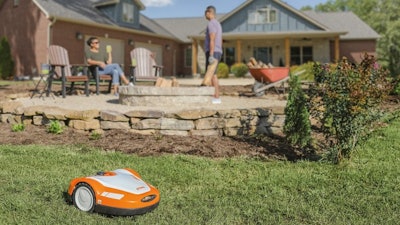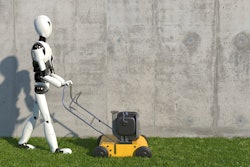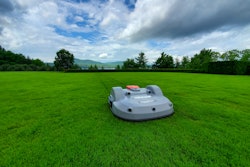
Emerging technologies are constantly changing the way work is performed in a variety of industries – and landscaping is no different. From GPS for equipment tracking to software aimed at streamlining business processes, innovative technology continues to move the industry forward.
Enter robotic lawnmowers. These autonomous, battery-powered machines are already transforming residential homeowners’ lawncare methods – but what are they? What is the technology behind them, and how might they benefit landscaping contractors?
Green Industry Pros consulted with a panel of robotic mower experts to get the answers to these questions and more. Mean Green Mowers founder and president Joe Conrad; Echo Incorporated president, product services and robotics Joe Fahey; Stihl product manager Brian Manke; Honda lawn and garden products marketing manager Elisha Lipscomb; and Left Hand Robotics co-founder and CEO Mike Ott all offered valuable insights into robotic mowers and their current and potential commercial applications.
What Are Robotic Lawnmowers?
Robotic mowers are very similar to robotic vacuum cleaners in the way they operate. For most robotic mowers, a guide wire is placed along a lawn’s perimeter – the mower then automatically trims the grass located inside the boundaries of the wire. When it’s not in operation, a robotic lawnmower returns to a docking station to charge its battery.
Honda’s Elisha Lipscomb provided an easy-to-understand definition.
“Overall, a robotic mower is a battery-operated device that cuts your lawn essentially without [people] having to interact physically. Robotic mowers cut your lawn autonomously, they mow and charge independently,” she said. “There is no need to be involved at all. They basically operate using the information from sensors that work in tandem with a low-voltage wire that's placed along the perimeter of your lawn. That wire can be buried or on top of your lawn.”
Mean Green Mowers’ Joe Conrad said currently, there is rapid growth of small (less than 20”) mowers being used in small areas.
“Almost all use a buried wire around the perimeter or some kind of base station to define the perimeter,” he said. “These small lawn mower robots typically randomly drive around for hours day in and day out over the same small piece of property in order to keep it all cut.”
History and Technological Evolution
Conrad explained that, while many of us tend to think of robotic mowers as a new technology, they have actually been around for many years in one iteration or another.
“Robotic mowers have been around for decades, but their widespread use is just now becoming practical,” he added. “In the past, most robots were confined to movement by very mechanical means with hydraulic cylinders and pumps.”
Conrad continued, “With the advent of affordable portable computers in the 1990s, robotics became much more sophisticated, but were still limited by computer processing power and battery power. In the last decade, leaps in advancements in computers and the first real practical long-life, high-density, lithium battery was developed. With the processing power and battery runtime problems addressed, basic robotics became somewhat practical.”
Autonomous mowers have been popular in Europe for years and are now gaining traction in North America.
Husqvarna is generally credited with having pioneered and shaped the robotic mowing segment with its Solar Mower in 1995, eventually leading to the development of its popular Automower.
Over the past 25 years, the machines have continued to advance. For example, though most robotic mowers mow in a random pattern, some of the latest models are being designed to follow “intelligent patterns.”
Mike Ott from Left Hand Robotics also mentioned the machines’ history and detailed how they have advanced over time.
“Historically, robotic mowers have essentially been small, electric machines that drive around randomly in an area defined by a perimeter wire,” Ott said. “More recently, these machines are beginning to incorporate ‘intelligent’ driving patterns (instead of random) and some are even using technologies other than a buried wire to define the perimeter of an area.”
Lipscomb also discussed the different directional options available on today’s robotic mowers. Honda’s residential robotic mower Miimo offers three different cutting patterns.
“The three different patterns are random, directional or mixed, which is a combination of random and directional. Also, if you have higher concentrations of grass, it'll do a spiral pattern until that heavier grass is cut,” she said.
Conrad also mentioned advancements in intelligent cutting design via GPS and artificial intelligence (AI). He said some advanced machines have added GPS in order to cut in straight lines and reduce the amount of time to cut the same piece of ground.
“The next big advance has been in computer vision and artificial intelligence. Old fashioned wire or base station borders and line-of-site GPS signals have kept autonomous mowing from growing rapidly,” Conrad stated. “The latest ‘vision’ driven robots do not have the limitations of a border or lose GPS reception when under a tree. New computer vision partnered with artificial intelligence means that a robot can now navigate freely and even make ‘educated’ decisions when encountering unusual terrain or objects. Mean Green Mowers’ all-electric commercial mowers can now provide a practical platform for the autonomous mower to develop.”
Stihl’s Brian Manke believes the merging of technologies and new advancements will continue to drive costs down, making robotic mower usage more feasible for contractors.
“[Robotic mowers represent] a convergence of technologies,” he said. “There are a lot of things that are coming together to make this a very viable solution in the marketplace.”
Manke continued, “First, they're battery powered. So, you see the evolution of battery products, batteries, electric motors, all the components – and the costs for all of those items are coming down. The costs are also coming down for the technology available to write the software, to run these products, to make them safe and make them function properly.”
According to Manke, the current and expected future reductions in robotic technology costs are comparable to how cell phone billing practices have been changing as of late.
“If you think back even a few years ago to how much your monthly cell phone bill was for data usage, and you compare that with where we're at today – it's a night and day difference,” he said. “So, when you look at all of the technological pieces that are needed to make a robotic lawn mower work and be affordable and to offer a return on investment, all of those pieces are coming together.”
Potential Benefits for Landscapers
When it comes to the landscaping industry, efficiency, quality and cost-effectiveness are key to running a successful business. Robotic mowers provide landscapers with an opportunity to offer continuous high-quality results.
“Basically, a robotic mower works within a perimeter wire and mows continuously in a random manner,” Fahey said. “Because they mow continuously, only a small amount is taken off with each cut. This creates less stress on the turf. Over time the turf gets thicker and stays green longer during dry periods. In addition, it has a ‘just mowed’ look all the time, not just once a week.”
He feels there is definitely a place for robotic mowers in the landscaping business model.
“A number of landscape companies have begun putting small robots on homeowner properties and supporting them with weekly trimming services. This can also be true for commercial properties,” Fahey said. “Landscape companies can offer that ‘just mowed’ look and better turf health at a different price structure because labor is limited. In addition, we have been contacted by many corporate and education campuses who are looking for options which are quieter and more eco-friendly.”
Manke agreed, noting the reason golf courses look so good is due to being mowed every few days.
“A robotic lawnmower, if it's set up right, is mowing often enough [for that level of quality],” he said. “It's kind of like Groundhog Day, the grass looks exactly the same every day. And not only that, but because of how you're mowing it, you don't have the grass clippings. It's better for the grass, more of the nutrients are being returned.”
Continuing, Manke said, “Robotic lawnmowers don't kick up the dust, they're not noisy. So, [they also offer a] huge allergy benefit, especially if it's operating around a retirement community, school or hospital.”
Lipscomb also spoke on the quiet, efficient operation of robotic mowers.
“Because a robotic mower is so quiet, you can even set it to mow at night and you don't have to worry about bothering your neighbors,” she said. “Unlike a traditional lawnmower, robotic mowers (including Miimo) put out no emissions. So, they’re perfect for those who are green-conscious.”
Cost-savings was also touted as a substantial benefit of the robotic mowers.
“Robotic mowers will certainly have a big effect on many professional landscape companies,” Conrad said. “Initially, most savings will be in reduced fuel and routine maintenance costs thanks to the all-electric platform. Even greater savings will come from reduced labor cost since a robotic mower will take the place of a person.”
Ott also believes robotic mowers represent a path to cost- and time-savings.
“It’s clear the shortage of labor is significantly impacting professional landscaping companies and whether you are looking to maintain your current portfolio of contracted properties with fewer people OR if you’re looking to expand your business with the employees you have, robotic equipment is a great way to achieve those objectives,” he said.
Manke also believes robotics could enable contractors to pick up more work despite the labor shortage. “We've heard countless stories of people that are turning down contracts and turning down business because they just don't have the people to do it,” he said.
Lipscomb detailed how robotic mowers increase both efficiency and productivity, while working in tandem with a human workforce. She said, “Robotic mowers are really allowing the landscape industry to reallocate resources. [Contractors can] send out smaller crews to be able to tackle more properties in a given amount of time. Crews can focus on trimming and edging and doing the smaller tasks while the robotic mower does the mowing. Essentially, it's reallocating those resources to make them more productive while they're out in the field.”
Commonly Asked Questions/Considerations
When adopting new methods for work completion, there will always be factors to consider and concerns to address. The primary concern that many landscapers voice with regard to robotic mowers is a fear that the machines will take away human jobs.
The experts interviewed were quick to point out that landscaping will always be a human-driven field. While robotics can help contractors perform duties more efficiently and effectively, there will still be a strong need for workers in all aspects of the industry.
“A common question from landscape professionals is about reduction of labor or loss of jobs. That would be a ‘glass half empty’ view,” Fahey said. “The other way to view robotics is, if you keep labor constant, how much more revenue could you generate by placing robots with more accounts? Autonomous mowing can offer superior results, lower cost and new opportunities for landscapers.”
He believes robotics will prove to be increasingly popular in the industry. “The professional landscape industry is asking the right questions about this new technology and soon will begin featuring robotic mowers in the menu of services to their commercial customers,” said Fahey.
Conrad added that there will still be a need for a ‘handler’ and large-area mowing will be the most practical, but the robotic mowers will gradually be used effectively in smaller yards as well.
“Someday in the near future, it will not be uncommon to see an autonomous electric truck pulling a trailer full of electric autonomous mowers that pull up to a property, autonomously unload, mow, reload, and then move on to the next job,” he said.
Manke echoed these sentiments.
“It’s a lot like manufacturing. Even if you go into a super-modern plant, there will still be people,” he said. “They're doing people things, but you have robotics doing repetitive tasks that don't necessarily make sense to have a person doing. And that's where we're starting to get at here is you've got a lawn mower that can handle the basic mowing, whereas you need the person to turn the bushes, sculpt the hedges and the sidewalk and do the things that require that human touch. But for the basic middle of the yard, mow the grass, keep it looking nice, we're getting to that point now where a robot makes sense.”
Safety and security are the other two big concerns. With regard to safety, robotic mowers are outfitted with sensors that cause the machine to instantly stop and shut off when an animal or person is in its path. They are also equipped with several features that deter theft.
“As soon as you connect [robotic mowers] to a cellular connection, they have GPS,” Manke said. “If it is taken too far from its home zone, you will be notified through the app. And similar to your phone, there's a pin code locked to the machine.” The same technology notifies you if the mower gets stuck because of a toy or something else on the lawn that blocks it.
Robotic mowers are also smartly designed to notify users when they need maintenance.
“Periodically the blades have to be changed. If the blades need to be changed, you'll get that notification,” said Manke.
Future Projection for Robotic Mower Usage in Landscaping
One final consideration is the fact that robotic mowers have traditionally been used to mow small areas, but this is changing as machines evolve. For instance, Fahey explains that Echo focuses primarily on the commercial market.
“There have been a number of homeowner-sized units available in the market that have a mowing capacity of 1.5 acres or less,” he said.
However, ECHO Robotics focuses on the commercial market with larger units featuring capacities of up to 3 or 6 acres.
“Our robotic mowers have a number of commercial grade features, including: 3 or 5 cutting heads which float, giving a level cut even on uneven terrain, durable metal frame for stability, large-drive wheels, robust software which gives a broad array of functions and is regularly updated with increased functionality and connectivity which allows the customer to monitor performance and give commands remotely,” Fahey said.
Mean Green Mowers is currently partnering with The Kobi Company to produce an all-electric autonomous 74” zero-turn mower with computer vision and artificial intelligence (no GPS guidance or buried wires).
Conrad said at GIE+EXPO 2019, Mean Green demonstrated a prototype in the outdoor area. It showed how the machine could start working on its own, cut in straight lines, maneuver around objects and stop when encountering a certain object (like a human).
He said plans are to test and certify the 74” “ATOM” mower in 2020 and start sales in 2021.
In terms of advancing the field, Husqvarna announced in October 2019 it will introduce its next autonomous mowing development, Husqvarna Autonomous Operation for professionals. It consists of multiple self-operated Husqvarna robotic mowers powered by Husqvarna EPOS technology. Three pilots were being established in 2019 to refine the system before an official launch in 2021.
Husqvarna's EPOS technology is a high-precision satellite navigation system that provides enhanced real-time positioning accuracy, delivering location accuracy of 2-3 cm (0.79-1.18 in.). The Husqvarna EPOS technology enables the machine to navigate, within and between work areas, using virtual boundaries. The operational efficiency is increased due to the ability to operate the machines at any time.
“Robotics and autonomous solutions will play a major role in the future of green space management,” Sascha Menges, President Husqvarna Division said. “We are committed to continuously improving professional green space management and Husqvarna EPOS is a technological breakthrough in Husqvarna’s robotic mowing that will further accelerate the adaptation of robotics in professional lawn care.”
In its first implementation, Husqvarna Autonomous Operation is using Husqvarna's new hybrid Rider lawnmowers. The new technology is the next step in Husqvarna professional robotic lawnmowing and will be launched with selected professional customers in the U.S, France, Germany and Sweden in 2020.
“Probably the main message to share with professional landscapers is that commercial-class, large-area, robotic mowing solutions are now available to help them deal with our nation’s labor crisis,” Ott said. “While many are aware of the smaller, electric robotic mowers that are really only suitable for specific residential-type applications, our machines with their 37hp EFI engines, fully hydraulic 4-wheel drive powertrains, 63” finish mower decks, 12-gallons of fuel on-board, sophisticated area-mapping capabilities and automatic job report documentation have now brought a solution to market that is changing the game for professional landscaping contractors across North America.”
Manke reiterated the need for efficiency in the landscaping industry.
“You want to get as much done as possible,” he said. “I think the fact that we’re already integrating telematics technology and GPS tracking goes right along with the trends we've been seeing in equipment and construction and landscaping recently. We're seeing telematics on everything now, which is great because equipment can be really expensive, especially if you're a small business owner. It's all about being more efficient.”
The panel of experts seemed to agree that there will continue to be growth and expansion within the robotic mower segment of the industry.
“As more technology improves with batteries and greater connectivity is required by end users, I think you'll see robotic mowers becoming more of the mainstream in the future,” Lipscomb said. “We at Honda are excited to be a part of that evolution of our industry.”


![Doosan Bobcat Wacker Neuson Stack 2ec Js Pb V6e[1]](https://img.greenindustrypros.com/mindful/acbm/workspaces/default/uploads/2025/12/doosan-bobcat-wacker-neuson-stack2ecjspbv6e1.CPyyz8ubHn.png?auto=format%2Ccompress&bg=fff&fill-color=fff&fit=fill&h=100&q=70&w=100)








![Doosan Bobcat Wacker Neuson Stack 2ec Js Pb V6e[1]](https://img.greenindustrypros.com/mindful/acbm/workspaces/default/uploads/2025/12/doosan-bobcat-wacker-neuson-stack2ecjspbv6e1.CPyyz8ubHn.png?ar=16%3A9&auto=format%2Ccompress&bg=fff&fill-color=fff&fit=fill&h=135&q=70&w=240)








